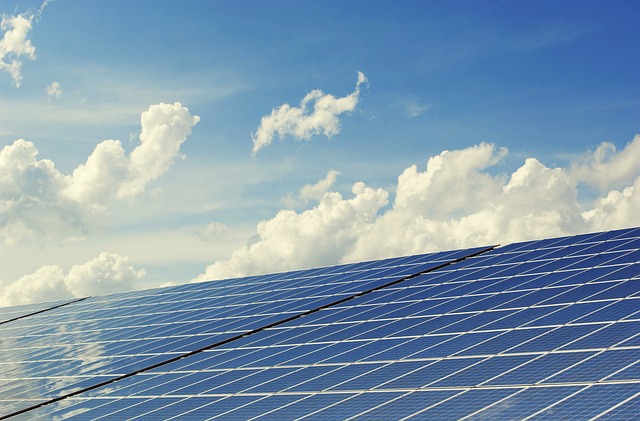“Power Your Future: Mastering Solar Panel Wiring for Hybrid Systems!”
Wiring solar panels for a hybrid system involves integrating both solar energy and an alternative power source, such as the grid or a generator, to create a versatile and efficient energy solution. A hybrid system allows for the use of solar power during the day while providing backup options during periods of low sunlight or high demand. This introduction outlines the essential components, safety considerations, and step-by-step procedures for properly wiring solar panels in a hybrid setup, ensuring optimal performance and reliability. Understanding the configuration of solar panels, inverters, batteries, and charge controllers is crucial for achieving a seamless energy flow and maximizing the benefits of renewable energy.
Understanding Hybrid Solar Systems
Understanding hybrid solar systems is essential for anyone considering the integration of solar energy into their home or business. A hybrid solar system combines the benefits of both grid-tied and off-grid systems, allowing users to harness solar energy while maintaining a connection to the utility grid. This unique configuration not only provides flexibility but also enhances energy security, making it an increasingly popular choice among homeowners and businesses alike.
At the core of a hybrid solar system is the solar panel array, which captures sunlight and converts it into electricity. This electricity can be used to power appliances and devices directly, reducing reliance on the grid. However, what sets hybrid systems apart is their ability to store excess energy in batteries for later use. This feature is particularly advantageous during periods of low sunlight or during power outages, as it ensures a continuous power supply. By incorporating battery storage, users can optimize their energy consumption, utilizing solar power when it is most abundant and drawing from the grid when necessary.
Moreover, hybrid systems are equipped with advanced inverters that manage the flow of electricity between the solar panels, batteries, and the grid. These inverters play a crucial role in ensuring that the system operates efficiently and safely. They convert the direct current (DC) generated by the solar panels into alternating current (AC), which is the form of electricity used in most homes. Additionally, modern hybrid inverters often come with smart technology that allows users to monitor their energy production and consumption in real-time, providing valuable insights into their energy usage patterns.
Transitioning to the installation of a hybrid solar system involves several key considerations. First and foremost, it is essential to assess the energy needs of the household or business. This assessment will help determine the size of the solar panel array and the capacity of the battery storage required. It is also important to evaluate the local climate and sunlight availability, as these factors will influence the system’s overall performance. Once these parameters are established, the next step is to select high-quality solar panels and batteries that are compatible with the chosen inverter.
When wiring solar panels for a hybrid system, it is crucial to follow proper electrical codes and safety standards. This process typically involves connecting the solar panels in series or parallel configurations, depending on the desired voltage and current output. Series connections increase voltage, while parallel connections increase current. The choice between these configurations will depend on the specifications of the inverter and the overall design of the system. Additionally, it is vital to incorporate appropriate fuses and circuit breakers to protect the system from overloads and short circuits.
Furthermore, integrating a hybrid solar system with existing electrical infrastructure requires careful planning. This includes ensuring that the system can seamlessly switch between solar power, battery storage, and grid electricity. A well-designed hybrid system will automatically prioritize solar energy usage, drawing from the grid only when necessary. This not only maximizes energy efficiency but also minimizes electricity costs.
In conclusion, understanding hybrid solar systems is fundamental for anyone looking to invest in renewable energy. By combining solar panels, battery storage, and smart inverters, these systems offer a versatile and reliable energy solution. As the demand for sustainable energy sources continues to grow, hybrid solar systems stand out as a practical choice for those seeking energy independence while remaining connected to the grid. With careful planning and execution, wiring solar panels for a hybrid system can lead to significant long-term benefits, both financially and environmentally.
Essential Tools for Wiring Solar Panels

Wiring solar panels for a hybrid system requires a careful selection of essential tools to ensure a safe and efficient installation. Understanding the tools needed not only simplifies the process but also enhances the overall effectiveness of the solar energy system. To begin with, a multimeter is indispensable for any solar panel installation. This tool allows you to measure voltage, current, and resistance, which are critical for diagnosing electrical issues and ensuring that the system operates within the desired parameters. By using a multimeter, you can verify that the solar panels are producing the expected output before connecting them to the hybrid inverter.
In addition to a multimeter, wire strippers are crucial for preparing the electrical connections. These tools enable you to remove the insulation from the wires without damaging the copper strands inside. Properly stripped wires are essential for creating secure connections, which in turn minimizes the risk of electrical faults. Furthermore, having a good set of crimping tools is beneficial for attaching connectors to the ends of the wires. Crimping ensures a solid mechanical and electrical connection, which is vital for the longevity and reliability of the system.
Another important tool is a drill, particularly if you need to mount solar panels on a roof or other surfaces. A power drill equipped with the appropriate bits allows you to create holes for mounting brackets, ensuring that the panels are securely fastened. It is advisable to use a drill with adjustable speed settings, as this provides better control when working with different materials. Additionally, a level is necessary to ensure that the solar panels are installed at the correct angle. Proper alignment maximizes sunlight exposure, which is crucial for optimizing energy production.
Safety equipment should not be overlooked when wiring solar panels. Personal protective equipment, such as gloves and safety glasses, is essential to protect yourself from electrical hazards and debris. Moreover, having a first aid kit on hand is a prudent measure, as it prepares you for any unforeseen accidents that may occur during the installation process. It is also wise to have a fire extinguisher nearby, as electrical work can pose fire risks if not handled correctly.
As you gather your tools, consider the importance of quality over quantity. Investing in high-quality tools can make a significant difference in the ease and safety of your installation. For instance, using high-grade connectors and wiring can prevent issues related to corrosion and overheating, which are common in solar energy systems. Additionally, having a reliable set of pliers can assist in tightening connections and handling various components with precision.
Lastly, it is beneficial to have a comprehensive installation manual or guide specific to your hybrid system. This resource can provide valuable insights into the wiring process, including diagrams and specifications that are tailored to your equipment. By following a structured approach and utilizing the right tools, you can ensure that your solar panel installation is not only efficient but also safe and compliant with local regulations.
In conclusion, wiring solar panels for a hybrid system requires a thoughtful selection of essential tools, including a multimeter, wire strippers, crimping tools, a drill, and safety equipment. By equipping yourself with these tools and adhering to best practices, you can successfully navigate the complexities of solar panel installation, ultimately contributing to a more sustainable energy future.
Step-by-Step Wiring Process for Hybrid Systems
Wiring solar panels for a hybrid system involves a systematic approach that ensures efficiency and safety. To begin with, it is essential to gather all necessary components, including solar panels, an inverter, a charge controller, batteries, and appropriate wiring. Each component plays a crucial role in the overall functionality of the hybrid system, which combines both solar energy and grid power to optimize energy usage.
Once you have all the components ready, the first step is to determine the layout of your solar panels. This involves deciding how many panels you will use and their arrangement. It is advisable to position the panels in a location that receives maximum sunlight exposure throughout the day. After establishing the layout, you can proceed to mount the solar panels securely on a roof or a ground-mounted structure, ensuring they are angled correctly to capture sunlight effectively.
Next, you will need to connect the solar panels in series or parallel, depending on your system’s voltage requirements. Connecting in series increases the voltage, while connecting in parallel increases the current. For most hybrid systems, a combination of both configurations may be necessary to achieve the desired output. Once the panels are connected, use appropriate gauge wiring to connect them to the charge controller. It is crucial to follow the manufacturer’s specifications for wire size to prevent overheating and ensure optimal performance.
After connecting the solar panels to the charge controller, the next step is to wire the charge controller to the battery bank. The charge controller regulates the voltage and current coming from the solar panels to prevent overcharging the batteries. When wiring the charge controller to the batteries, ensure that you connect the positive terminal of the charge controller to the positive terminal of the battery and the negative terminal to the negative terminal. This step is vital for maintaining the integrity of the system and ensuring that the batteries are charged efficiently.
Once the charge controller is connected to the battery bank, you can proceed to wire the inverter. The inverter is responsible for converting the direct current (DC) from the solar panels and batteries into alternating current (AC), which is used by most household appliances. Connect the inverter to the battery bank, ensuring that the positive and negative terminals are correctly aligned. It is also important to check the inverter’s specifications to ensure it can handle the load of the appliances you intend to power.
With the inverter connected, the final step is to integrate the hybrid system with the grid. This involves connecting the inverter to your home’s electrical panel. It is crucial to follow local electrical codes and regulations during this process, as improper wiring can lead to safety hazards. If you are unsure about this step, it is advisable to consult a licensed electrician to ensure that the connection is made safely and correctly.
In conclusion, wiring solar panels for a hybrid system requires careful planning and execution. By following these steps—mounting the panels, connecting them to the charge controller, wiring the charge controller to the battery bank, connecting the inverter, and integrating with the grid—you can create a reliable and efficient hybrid solar energy system. As you embark on this project, remember that safety should always be your top priority, and when in doubt, seeking professional assistance can help ensure a successful installation.
Common Mistakes to Avoid When Wiring Solar Panels
When wiring solar panels for a hybrid system, it is crucial to be aware of common mistakes that can compromise the efficiency and safety of the installation. One of the most frequent errors is neglecting to read the manufacturer’s instructions thoroughly. Each solar panel and inverter may have specific wiring requirements, and overlooking these details can lead to improper connections, reduced performance, or even damage to the equipment. Therefore, taking the time to familiarize oneself with the guidelines provided by the manufacturer is essential for a successful installation.
Another common mistake is failing to use the appropriate gauge of wire. The wire gauge must be suitable for the current that will flow through it; using wires that are too thin can result in overheating and energy loss due to resistance. Conversely, using wires that are excessively thick can be unnecessarily costly and cumbersome. It is advisable to consult the National Electrical Code (NEC) or a professional electrician to determine the correct wire size based on the system’s voltage and current requirements.
Moreover, many installers overlook the importance of proper grounding. Grounding is vital for protecting both the solar panels and the inverter from electrical surges and lightning strikes. Failing to ground the system adequately can lead to equipment failure and pose safety hazards. Therefore, ensuring that all components are correctly grounded according to local codes and regulations is a critical step that should not be ignored.
In addition to grounding, another mistake often made is the improper placement of the solar panels. While this may seem unrelated to wiring, the orientation and angle of the panels significantly affect their performance. If the panels are not positioned to receive optimal sunlight, the entire system’s efficiency can be compromised, regardless of how well the wiring is executed. Therefore, it is essential to consider the location and angle of installation before proceeding with the wiring process.
Furthermore, many individuals underestimate the importance of using high-quality connectors and junction boxes. Cheap or incompatible connectors can lead to poor connections, which may result in energy loss or even electrical fires. Investing in reliable connectors and ensuring they are compatible with the system components can prevent these issues and enhance the overall reliability of the solar installation.
Another mistake to avoid is neglecting to plan for future expansion. As energy needs grow, many homeowners may wish to add more solar panels to their existing system. Failing to account for this possibility during the initial wiring can lead to complications and additional costs down the line. It is wise to design the wiring layout with future expansion in mind, allowing for easy integration of additional panels or components.
Lastly, one of the most critical mistakes is not testing the system after installation. Once the wiring is complete, it is essential to conduct thorough testing to ensure that everything is functioning correctly. This includes checking for voltage output, ensuring that all connections are secure, and verifying that the inverter is operating as intended. Skipping this step can lead to undetected issues that may affect the system’s performance and longevity.
In conclusion, wiring solar panels for a hybrid system requires careful attention to detail and an understanding of common pitfalls. By avoiding these mistakes, such as neglecting manufacturer instructions, using incorrect wire gauges, failing to ground the system, and overlooking future expansion, one can ensure a more efficient and reliable solar energy system. Taking the time to plan, invest in quality materials, and conduct thorough testing will ultimately lead to a successful installation that meets energy needs effectively.
Q&A
1. **Question:** What is the first step in wiring solar panels for a hybrid system?
**Answer:** The first step is to determine the system voltage and ensure that the solar panels are compatible with the inverter and battery bank voltage.
2. **Question:** How should solar panels be connected in a hybrid system?
**Answer:** Solar panels can be connected in series to increase voltage or in parallel to increase current, depending on the system requirements and inverter specifications.
3. **Question:** What components are necessary for wiring a hybrid solar system?
**Answer:** Necessary components include solar panels, a charge controller, an inverter, batteries, and appropriate wiring and fuses.
4. **Question:** How do you connect the charge controller in a hybrid solar system?
**Answer:** Connect the solar panel output to the charge controller’s solar input, then connect the battery bank to the charge controller’s battery output, ensuring correct polarity.
Conclusion
To wire solar panels for a hybrid system, first, ensure you have the appropriate components, including solar panels, a charge controller, an inverter, and batteries. Connect the solar panels in series or parallel based on your voltage requirements. Wire the panels to the charge controller, which regulates the power going to the batteries. Connect the batteries to the charge controller and the inverter, ensuring proper polarity. Finally, connect the inverter to your electrical system to supply power. Always follow safety guidelines and local regulations when installing the system. In conclusion, proper wiring and component selection are crucial for the efficient operation of a hybrid solar system, enabling seamless integration of solar energy with other power sources.




